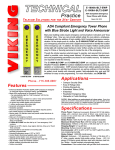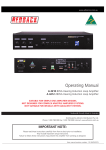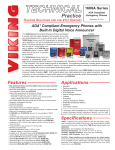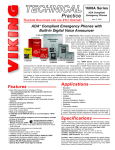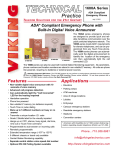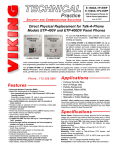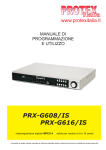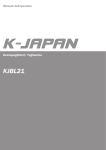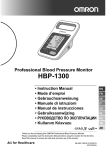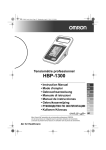Download Viking TBB-1A Specifications
Transcript
TECHNICAL
Practice
Practice
TELECOM SOLUTIONS
E-1600A-BLT-EWP
E-1600A-BLT2-EWP
ADA Compliant Emergency Tower
Phone with LED Strobe & Beacon
2 1 S T C E N T U RY
FOR THE
October 23, 2013
ADA Compliant Emergency Tower Phone with
Blue Steady On LED Beacon & Strobe Light
Many new building codes require emergency communication in elevators and “Area of Refuge”
sites. Now you can provide added safety for your patrons, employees, and students with the
addition of high visibility, ADA Compliant emergency communication. At the simple push of a button, the E-1600A-BLT-EWP will initiate a call to your emergency personnel and send a digital
announcement to identify the location of the emergency call. In addition, the tower phone’s bright
LED strobe light will instantly begin flashing to deter further activity and make it fast and easy for
Police or Security personnel to locate the site of the emergency. The strobe light can also be programmed to provide a continuous-on lower intensity beacon when the emergency phone is not
in use.
Though the strobe requires external power to operate, rest assured that communication is possible, even during power failures! All phone numbers, location numbers and programming
parameters are stored in non-volatile memory. No batteries are required to hold the memory.
The E-1600A-BLT-EWP and E-1600A-BLT2-EWP are equipped with Enhanced Weather
Protection (EWP) for outdoor installations where the unit is exposed to precipitation or condensation. EWP products feature foam rubber gaskets and boots, sealed connections, gel-filled butt
connectors, as well as urethane or thermal plastic potted circuit boards with internally sealed,
field-adjustable trim pots and DIP switches for easy on-site programming. For more information,
see DOD# 859.
E-1600A-BLT-EWP
E-1600A-BLT2-EWP
Phone...715.386.8861
Features
• Enhanced Weather Protection (EWP), EWP products are designed
to meet IP66 Ingress Protection Rating, see DOD# 859
• Meets ADA requirements for Emergency Phones:
- Can automatically light the “Call Connected” LED for the
hearing impaired
- Transmits a unique location I.D. code or voice announcement
- Grade 2 Braille label for the visually impaired
• 16 second non-volatile digital voice announcer
• High power LED strobe and beacon visual indicator:
- High output / long life LED technology
- Four programmable flash patterns: single, double, quad and flicker
- 6 programmable beacon and strobe brightness settings
• Advanced call progress detection
• Handsfree operation
• Phone line powered emergency phone (strobe requires power)
• Non-volatile memory (no batteries required)
• Marine grade 316 stainless steel and powder coated aluminum to
prevent corrosion
• Dials up to 5 emergency numbers
• Cycles through backup emergency and non-emergency numbers on
busy or no-answer
• E-1600A-BLT2-EWP can also dial up to 3 non-emergency “Info”
numbers
• Hangs up on CPC, silence, busy, dial tone, time-out or touch tone
• Programmable to auto-answer on incoming calls
• Remotely programmable
• Central Station Monitoring capability (dials 2 numbers)
• Separate central station voice speed dial number
• Optional PB-100 Polling System available
• Surface mountable
Applications
•
•
•
•
•
•
•
Campus Security Sites
Area of Refuge sites
Parking Ramps/Lots
Automated Tellers (ATM)
Entryways
Roadside Emergency Sites
Stairwells in Public Buildings
CAUTION - When installing on an analog extension of a phone system: Some phone
systems do not conform to analog telecom standards and might not be compatible with the
1600A Series emergency phones. For a detailed description of the telephone line specifications required for any of the 1600A Series phones, retrieve DOD# 869.
Specifications
Phone Power: Telephone line powered. Minimum 24V DC talk battery
voltage, with a minimum loop current of 20mA. Loop current may be
boosted on low current lines with a Viking Model TBB-1B talk battery
booster (DOD# 632)
Beacon/Strobe Power: 120V AC/12V DC power adapter (included)
Maximum Strobe Power Run: 200 feet using 24 awg wire
Dimensions: 1070mm x 152.4mm x 109.3mm (42” x 6” x 4.5”)
Shipping Weight: 9.1 kg (20 lbs)
Mounting: Surface mount to rigid wall or post
Environmental: -26°C to 54°C (-15°F to 130°F) with 5% to 95% non-condensing humidity
Strobe Flash Rate: 60 flashes per minute (default) see Strobe Flash
Patterns on page 7
Maximum Power Supply Run Length on CAT-5: 1 pair = 125 ft, 2 pair
= 225 ft, 3 pair = 325 ft, 4 pair = 475 ft
Material: Enclosure - .125 aluminum, 76.2mm x 152.4mm (3” x 6”) tube,
powder painted high-visible yellow, Phone - .074 (14 gauge) 316 Marine
grade stainless steel with stainless steel button, Strobe - Vandal resistant
polycarbonate plastic
Connections: Color-coded wires with gel-filled butt connectors
IF YOU HAVE A PROBLEM WITH A VIKING PRODUCT, PLEASE CONTACT: VIKING TECHNICAL SUPPORT AT (715) 386-8666
Our Technical Support Department is available for assistance Monday 8am - 4pm and Tuesday through Friday 8am - 5pm central time. So that we can give you better service, before you call please:
1. Know the model number, the serial number and what software version you have (see serial label).
2. Have your Technical Practice in front of you.
3. It is best if you are on site.
RETURNING PRODUCT FOR REPAIR
RETURNING PRODUCT FOR EXCHANGE
The following procedure is for equipment that needs repair:
1. Customer must contact Viking's Technical Support Department at 715-386-8666 to obtain a Return Authorization (RA)
number. The customer MUST have a complete description of the problem, with all pertinent information regarding the
defect, such as options set, conditions, symptoms, methods to duplicate problem, frequency of failure, etc.
2. Packing: Return equipment in original box or in proper packing so that damage will not occur while in transit. Static
sensitive equipment such as a circuit board should be in an anti-static bag, sandwiched between foam and individually boxed. All equipment should be wrapped to avoid packing material lodging in or sticking to the equipment. Include
ALL parts of the equipment. C.O.D. or freight collect shipments cannot be accepted. Ship cartons prepaid to:
Viking Electronics, 1531 Industrial Street, Hudson, WI 54016
3. Return shipping address: Be sure to include your return shipping address inside the box. We cannot ship to a PO Box.
4. RA number on carton: In large printing, write the R.A. number on the outside of each carton being returned.
The following procedure is for equipment that has failed out-of-box (within 10 days of purchase):
1. Customer must contact Viking’s Technical Support at 715-386-8666 to determine possible causes for the problem. The
customer MUST be able to step through recommended tests for diagnosis.
2. If the Technical Support Product Specialist determines that the equipment is defective based on the customer's input
and troubleshooting, a Return Authorization (R.A.) number will be issued. This number is valid for fourteen (14)
calendar days from the date of issue.
3. After obtaining the R.A. number, return the approved equipment to your distributor, referencing the R.A. number. Your
distributor will then replace the product over the counter at no charge. The distributor will then return the product to
Viking using the same R.A. number.
4. The distributor will NOT exchange this product without first obtaining the R.A. number from you. If you haven't
followed the steps listed in 1, 2 and 3, be aware that you will have to pay a restocking charge.
LIMITED WARRANTY
Viking warrants its products to be free from defects in the workmanship or materials, under normal use and service, for a period of one year from the date of purchase from any authorized Viking distributor or 18 months from the date manufactured, which ever is
greater. If at any time during the warranty period, the product is deemed defective or malfunctions, return the product to Viking Electronics, Inc., 1531 Industrial Street, Hudson, WI., 54016. Customer must contact Viking's Technical Support Department at 715-3868666 to obtain a Return Authorization (R.A.) number.
This warranty does not cover any damage to the product due to lightning, over voltage, under voltage, accident, misuse, abuse, negligence or any damage caused by use of the product by the purchaser or others. This warranty does not cover non-EWP products
that have been exposed to wet or corrosive environments.
NO OTHER WARRANTIES. VIKING MAKES NO WARRANTIES RELATING TO ITS PRODUCTS OTHER THAN AS DESCRIBED ABOVE AND DISCLAIMS ANY EXPRESS OR IMPLIED WARRANTIES OR MERCHANTABILITY OR FITNESS FOR ANY PARTICULAR PURPOSE.
EXCLUSION OF CONSEQUENTIAL DAMAGES. VIKING SHALL NOT, UNDER ANY CIRCUMSTANCES, BE LIABLE TO PURCHASER, OR ANY OTHER PARTY, FOR CONSEQUENTIAL, INCIDENTAL, SPECIAL OR EXEMPLARY DAMAGES ARISING OUT OF
OR RELATED TO THE SALE OR USE OF THE PRODUCT SOLD HEREUNDER.
EXCLUSIVE REMEDY AND LIMITATION OF LIABILITY. WHETHER IN AN ACTION BASED ON CONTRACT, TORT (INCLUDING NEGLIGENCE OR STRICT LIABILITY) OR ANY OTHER LEGAL THEORY, ANY LIABILITY OF VIKING SHALL BE LIMITED TO
REPAIR OR REPLACEMENT OF THE PRODUCT, OR AT VIKING'S OPTION, REFUND OF THE PURCHASE PRICE AS THE EXCLUSIVE REMEDY AND ANY LIABILITY OF VIKING SHALL BE SO LIMITED.
IT IS EXPRESSLY UNDERSTOOD AND AGREED THAT EACH AND EVERY PROVISION OF THIS AGREEMENT WHICH PROVIDES FOR DISCLAIMER OF WARRANTIES, EXCLUSION OF CONSEQUENTIAL DAMAGES, AND EXCLUSIVE REMEDY AND
LIMITATION OF LIABILITY, ARE SEVERABLE FROM ANY OTHER PROVISION AND EACH PROVISION IS A SEPARABLE AND INDEPENDENT ELEMENT OF RISK ALLOCATION AND IS INTENDED TO BE ENFORCED AS SUCH.
FCC REQUIREMENTS
This equipment complies with Part 68 of the FCC rules and the requirements adopted by the ACTA. Inside the front panel of this
equipment is a label that contains, among other information, a product identifier in the format US:AAAEQ##TXXXX. If requested, this
number must be provided to the telephone company.
The REN is used to determine the number of devices that may be connected to a telephone line. Excessive REN's on a telephone
line may result in the devices not ringing in response to an incoming call. In most but not all areas, the sum of the REN's should not
exceed five (5.0) To be certain of the number of devices that may be connected to a line, as determined by the total REN's, contact
the local telephone company. For products approved after July 23, 2001, the REN for this product is part of the product identifier that
has the format US:AAAEQ##TXXXX. The digits represented by ## are the REN without a decimal point (e.g., 03 is a REN of 0.3).
For earlier products, the REN is separately shown on the label.
The plug used to connect this equipment to the premises wiring and telephone network must comply with the applicable FCC Part
68 rules and requirements adopted by the ACTA. If your home has specially wired alarm equipment connected to the telephone line,
ensure the installation of this E-1600A-BLT-EWP or E-1600A-BLT2-EWP does not disable your alarm equipment. If you have questions about what will disable alarm equipment, consult your telephone company or a qualified installer.
If the E-1600A-BLT-EWP or E-1600A-BLT2-EWP causes harm to the telephone network, the telephone company will notify you in
advance that temporary discontinuance of service may be required. But if advance notice isn't practical, the telephone company will
notify the customer as soon as possible. Also, you will be advised of your right to file a complaint with the FCC if you believe it is necessary.
The telephone company may make changes in its facilities, equipment, operations, or procedures that could affect the operation of
the equipment. If this happens, the telephone company will provide advance notice in order for you to make the necessary modifi-
2
cations to maintain uninterrupted service.
If trouble is experienced with the E-1600A-BLT-EWP or E-1600A-BLT2-EWP, for repair or warranty information, please contact:
Viking Electronics, Inc., 1531 Industrial Street, Hudson, WI 54016 (715) 386-8666
If the equipment is causing harm to the telephone network, the telephone company may request that you disconnect the equipment
until the problem is resolved.
Connection to Party Line Service is subject to State Tariffs. Contact the state public utility commission, public service commission or
corporation commission for information.
WHEN PROGRAMMING EMERGENCY NUMBERS AND (OR) MAKING TEST CALLS TO EMERGENCY NUMBERS:
Remain on the line and briefly explain to the dispatcher the reason for the call. Perform such activities in the off-peak hours, such as
early morning or late evenings.
It is recommended that the customer install an AC surge arrester in the AC outlet to which this device is connected. This is to avoid
damaging the equipment caused by local lightning strikes and other electrical surges.
PART 15 LIMITATIONS
This equipment has been tested and found to comply with the limits for a Class A digital device, pursuant to Part 15 of the FCC Rules.
These limits are designed to provide reasonable protection against harmful interference when the equipment is operated in a commercial environment. This equipment generates, uses, and can radiate radio frequency energy and, if not installed and used in accordance with the instruction manual, may cause harmful interference to radio communications. Operation of this equipment in a residential area is likely to cause harmful interference in which case the user will be required to correct the interference at his own
expense.
Installation
!
IMPORTANT: Electronic devices are susceptible to lightning and power station electrical surges from both the AC outlet and the
telephone line. It is recommended that a surge protector be installed to protect against such surges.
A. Wiring
Rear View of the
E-1600A-BLT-EWP Phone Panel
1600A Emergency
Phone Board
BLK-4 Control
Module
Ring Connector
(included)
Marine grade 316
stainless steel
faceplate and push
button switch
(sealed per IP67)
* Earth Ground
(optional)
** Gel-Filled Butt
Connectors (included)
Note: Polarity Sensitive!
BLK-4
Control
Module
(included)
Incoming Analog
Phone Line
120V AC
12V DC
Adapter
(included)
(+) Red with
Black stripe
Positive
(-) Black with
Red stripe
Negative
*** Drip
Loop
Rear View of the SL-2
Strobe Light (included)
Rear View of Legacy
SL-1 Strobe Light
see Programming page 6
(included with 2012 and
older E-1600A-BLT-EWP
models)
Red with
Yellow stripe
Green with
Yellow stripe
Note: Not polarity
sensitive.
Red (+)
Black (-)
Green (see section F page 6)
Black
Red
Phone or
Terminal Device
(not included)
Disable Feature
(see section E on page 6)
Auxiliary Relay Contact Output
Brown
(see section D on page 5)
Gray
Blue
Orange
Trigger Input for Optional
Remote Trigger Switch
(see section G on page 6)
White
DIP Switch 4 ON
N.C.
+12VDC Normally ON
Purple
COM
+12VDC
Yellow
N.O.
+12VDC Normally OFF
Blue
White
DIP Switch 4 OFF
* Note: To increase surge protection, loosen the PCB mounting screw labeled
(as shown) and fasten a wire with ring connector (included) from the mounting screw to Earth Ground (grounding rod, water pipe, etc.)
** Note: The gel-filled (water-tight) butt connectors are designed for insulation displacement on 19-26 gauge wire with a maximum
insulation of 0.082 inches. Cut off bare wire ends prior to terminating.
*** Note: When wires are routed from above, a “drip loop” is recommended to keep water away from the circuit board.
3
B. Mounting
Strobe Panel Mounting
0.35"
Diameter
3.12"
SL-2 Strobe/Beacon
Front
View
E
M
E
R
G
E
N
C
Y
42.0"
High Visibility
Safety Yellow
Powder Paint
Use 5/16" bolt
and flat washer
(included)
Rear
View
35.76"
Bottom View
2.87"
1.37"
Knockout for
1/2 inch conduit
E
M
E
R
G
E
N
C
Y
(4) Stainless steel spanner
head screws (bit and
screws included)
Adhere gasket to chassis,
centering over mounting holes
Phone Panel Mounting
NCY
RGE
EMEHONE
P
P
HEL
INFO
CALL
TED
NEC
CON
Grade 2 Braille Label
Condensation
Drain Hole
"Help" Push to Call Button
1.5"
3.0"
6.0"
0.35"
Diameter
1.25"
Call Connected Red LED
0.875"
Diameter
3.0"
4
"Info" Push to Call Button
(E-1600A-BLT2-EWP Only)
Adhere gasket to chassis,
centering over mounting holes
(4) stainless steel spanner
head screws (included)
Rain Guard (included)
Condensation Drain Hole
Step 1.
Mount the tower phone approximately 42” above the floor to a flat, sturdy surface using 5/16 hardware.
Note: Flat washers should be used on the main mounting bolts for additional strength.
Step 2.
Locate the strobe light panel and pass the red and black wires from the strobe panel through the gasket
and the upper hole in the tower.
Step 3.
Mount the strobe panel to the tower using the four security screws provided.
Step 4.
Locate the phone panel. Using the gel-filled butt connectors, connect the red and black wires labeled
“Strobe Light” to the red and black wires on the strobe panel.
Step 5.
Connect the phone line to the red and green wires (this connection is not polarity sensitive).
Step 6.
Connect the 12V DC adapter wires (-) and (+) to the black with red stripe (-) and red with black stripe (+)
wires from the BLK-4 control module.
Step 7.
Mount the phone panel to the tower using the remaining four security screws.
BLK-4 Control Module Programming
A. DIP Switches
BLK-4 Control Module
Switch 1 Switch 3 Description (see section B)
ON
OFF
Ring Detection Only
OFF
ON
Off-Hook/Loop Current Detection Only
ON
ON
Ring and Off-Hook/Loop Current Detection
Switch 2 Ring Cadence Mode (see section C)
ON
Ring Cadence Mode ON - relay remains activated in between rings.
OFF
Ring Cadence Mode OFF - relay is activated only during ringing.
Switch 4 Auxiliary Relay Contacts (see section D)
ON
Wet (12VDC, 100mA maximum)
OFF
Dry (1 Amp maximum @ 30VDC)
ON
1 2 3 4
B. Configuring for Ring and/or Loop/Off-Hook Indication
1. Ring Indication Only
Place DIP switch 2 on the 1600A emergency phone board in the OFF position (not shown in the diagram - see
1600A Emergency Phone Board Programming section J). Note: With DIP switch 2 in the OFF position, the
1600A emergency phone board will not answer an incoming call. The LDB-3 control module can monitor for ringing any place along the ringing line. Place DIP switch 1 ON and DIP switch 3 OFF.
2. Loop/Off-hook Indication Only
Place DIP switch 1 OFF and DIP switch 3 ON. In this configuration, the E-1600A-BLT-EWP will only flash the strobe
light while off-hook (while the emergency phone is in use).
3. Both Ring and Loop/Off-hook Indication
If the application requires ring and loop/off-hook indication, place DIP switch 1 and 3 in the ON position.
C. Ring Cadence Mode
DIP switch 2 is used for switching between different ring detection modes. In the OFF position, the strobe light and
relay will activate only while ring voltage is present and will turn off between rings. In the ON position, the strobe light
and relay will remain on for up to 5.75 seconds after the ringing has stopped. This allows the strobe light and relay to
remain on between rings of a standard ring cadence. Note: To use the Ring Cadence Mode, ring detection MUST be
enabled (DIP switch 1 - ON).
D. Auxiliary Relay Contacts
With DIP switch 4 OFF, normally open and normally closed dry relay contacts are available on the orange, purple and
yellow wires. The contacts are rated at .5A @ 125VAC/1A @ 30VDC. If contacts are driving an inductive load, place
a suppression device at the load to snub high voltage spikes.
With DIP switch 4 ON, wet/switched +12VDC (100mA maximum) will be output on the yellow wire and “-” (GND) on the
black wire.
5
E. Disable Feature
The “Disable” input can be connected to a switch for remotely disabling/turning off the strobe light and the device controlled by the auxiliary contacts (camera, etc.). Note: The disable feature on the E-1600A-BLT2-EWP is factory prewired to the “Info” push button. This prevents the strobe from activating when the “Info” push button is pressed.
F. Switched 12V DC Output
The switched 12V DC output is a low current, 12-15VDC output that is turned on only while the trigger input is closed
or ring/loop detect relay is activated. This switched power output is ideal for triggering the included strobe light or providing 12-15V DC power to any device that draws less than 400mAmps. The positive side is available on the green
wire, and the negative side is on the black wire. Once all the line and load connections have been made, plug in the
115 V AC wall adapter, and replace the cover.
G Trigger Input
The trigger input is available on the two white wires. The Strobe Light, Auxiliary relay contact and the switched 12 VDC
output will be activated for the duration of the contact closure across the two white wires.
P r o g r a m m i n g t h e S L - 2 St r o b e / B e a c o n
The SL-2 can be user programmed as a Beacon only, Strobe only or Beacon/Strobe. The brightness setting can be programmed separately for the Strobe or Beacon and one of 4 different Flash Patterns can be programmed for the Strobe (See
Strobe Flash Patterns, section D). Note: The SL-2 is factory default programmed as a steady on beacon with a single flash
strobe when activated. The beacon and strobe are set to their brightest settings. All programming should be done prior to
connecting to the BLK-4 control module.
A. Accessing the Programming Mode
(Optional, the SL-2 is factory programmed to the Beacon/Strobe Mode and brightest Beacon/Strobe settings).
Step 1. Apply 10-15 VDC power to the Red (+) and Black (-) wires.
Touch and hold the Green (Control) wire to the Black (-) wire for 3 seconds. The strobe should flash twice.
You are now in Programming mode. Note: Once in the programming mode, if a programming command
Step 2.
has not been entered for 20 seconds the strobe will flash 3 times indicating the unit has exited programming and returned to the Run Mode.
B. Programming Desired Features (after accessing Programming Mode above)
Select the Feature: Momentarily touch the Green (Control) wire to the Black (-) wire 1 to 10 times to select which feature to program (see Programming Features List, section C). The strobe should momentarily flash each time the Green (Control) wire has
touched the Black (-) wire.
Features 1-3 & 6-10: After selecting Programming Features 1-3 or 6-10, wait 3 seconds and the strobe should flash 2 times indicating that feature has been programmed. You can now exit programming or move on to programming the Beacon or Strobe brightness settings.
Setting Strobe Brightness (factory set to 6/Brightest): After selecting Programming Feature 4 (Strobe Brightness), wait 3 seconds
and the strobe should begin flashing in the preprogrammed flash pattern. Touch and hold the Green (Control) wire to the Black (-)
wire. The SL-2 will begin flashing the strobe cycling through 6 different brightness settings from lowest to highest. When the SL-2
flashes at the desired brightness level immediately remove the Green wire from the Black. The SL-2 should flash twice indicating
the selected brightness level has been set.
Setting Beacon Brightness (Factory set to 6/Brightest): After selecting Programming Feature 5 (Beacon Brightness), wait 3 seconds and the beacon will light at its preprogrammed beacon brightness setting. Touch and hold the Green (Control) wire to the Black
(-) wire. The SL-2 will begin stepping through 6 different beacon brightness settings from lowest to highest. When the SL-2 lights at
the desired beacon brightness level immediately remove the Green wire from the Black. The SL-2 should flash twice indicating the
selected brightness level has been set.
6
Exiting Programming: To exit programming simply wait 20 seconds from the last programming command and the unit will flash 3
times. This indicates the SL-2 has exited the programming mode and is now in the Run mode. Note: To eliminate waiting 20 seconds, you can also exit programming after the last programming command by touching and holding the Green (Control) wire to the
Black (-) for 3 seconds. The strobe will flash 3 times indicating the unit has exited the programming mode and is now in the Run
mode.
C. Programming Features List
Feature #:
Description:
Feature #:
Description:
1
Beacon/Strobe (factory default)
6
Single Flash Strobe (factory default)
2
Strobe Only
7
Double Flash Strobe
3
Beacon Only
8
Quad Flash Strobe
4
Strobe Brightness 1-6 (factory default = 6,
brightest setting)
9
Flicker Flash Strobe
10
Reset to Factory Default Settings
5
Beacon Brightness 1-6 (factory default = 6,
brightest setting)
D. Strobe Flash Patterns
0.80 sec
0.20 sec
Repeat
Single
Flash:
ON
0.10
sec
OFF
0.10
sec
0.10
sec
0.80 sec
Repeat
Double
Flash:
ON
OFF
OFF
ON
0.10
sec
0.05
sec
0.80 sec
Repeat
Quad
Flash:
ON
0.025
sec
Typ.
OFF
ON
OFF
ON
OFF
OFF
ON
0.025
sec
Typ.
0.80 sec
Flicker
Flash:
ON
OFF
ON
OFF
ON
OFF
ON
OFF
ON
OFF
ON
OFF
ON
OFF
ON
Repeat
OFF
8 Pulses
Operation
A. Ring Indication (DIP Switch 1 ON)
When the control module detects an incoming ring signal, it activates a set of normally open or normally closed contacts and turns on the 12VDC output for activating the provided strobe light. With the Ring Cadence mode off (DIP
switch 2 OFF), the relay will activate and the strobe light will flash only during ringing. With the Ring Cadence mode
ON (DIP switch 2 ON), the relay will remain activated and the strobe light will remain flashing between rings.
B. Off-Hook Indication (DIP Switch 3 ON)
When the control module detects an off-hook condition (“Help” button is pressed) on the brown and gray wires, it activates a set of normally open or normally closed contacts and turns on the 12VDC output for activating the provided
strobe light. The relay contacts will remain activated and the blue strobe light will flash during the off-hook condition
and will stop flashing approximately 3 seconds after the phone/terminal device on the brown and gray wires is back onhook. Note: A call initiated from the “Info” push button on the E-1600A-BLT2-EWP will not activate the strobe light.
7
1600A Emergency Phone Board Programming
A. Accessing the Programming Mode
The 1600A Series emergency phones can be programmed from any Touch Tone phone using a C.O. line, analog
PABX/KSU station, or a DLE-200B Line Simulator. For more information on the DLE-200B, see DOD# 605.
1. Using the Security Code
Step 1. Move DIP switch 2 to the ON position (sets unit to answer incoming calls, see section J).
Step 2. From a Touch Tone phone call the line attached to the 1600A Series phone.
Step 3. When the 1600A Series phone answers, enter the 6-digit security code (factory set to 845464, see section C). A
double beep should then be heard indicating you have entered the programming mode.
2. Without the Security Code
Step 1. Move DIP switch 2 to the ON position (sets unit to answer incoming calls, see section J).
Step 2. Move DIP switch 3 to the OFF position (incoming calls enter Programming without security code, see section J).
Step 3. From a Touch Tone phone call the line attached to the 1600A Series phone.
Step 4. When the 1600A Series answers, a double beep will be heard and will automatically enter the programming mode.
Step 5. When finished programming, move DIP switch 3 back to the ON position (see section J).
Warning: Failure to do step 5 above will cause the 1600A Series phone to call Viking Technical Support instead of your programmed number.
Note: If a valid memory position is entered, a double beep will be heard, four beeps indicate an error.
B. Quick Programming Features
Enter Digits - then - Enter Memory Location
First emergency speed dial number ......................................................................... 0-20 digits
Second emergency speed dial number ................................................................... 0-20 digits
Third emergency speed dial number ....................................................................... 0-20 digits
Fourth emergency speed dial number ..................................................................... 0-20 digits
Fifth emergency speed dial number ......................................................................... 0-20 digits
Central station receiver number ............................................................................... 0-20 digits
Central station voice number ................................................................................... 0-20 digits
First “Info” speed dial number (E-1600A-BLT2-EWP) ............................................. 0-20 digits
Second “Info” speed dial number (E-1600A-BLT2-EWP only) ................................. 0-20 digits
Third “Info” speed dial number (E-1600A-BLT2-EWP only) ..................................... 0-20 digits
Voice announcer/miscellaneous options (factory set to 000210) ............................. 6 digits
Timing/Dialing options (factory set to 234111) ......................................................... 6 digits
Security code (factory set to 845464) ...................................................................... 6 digits
Identification number (factory cleared) .................................................................... 0-20 digits
Second central station identification number (factory cleared) ................................. 0-20 digits
To add a Q at any point in the dialing string .............................................................. QQ
To add a # at any point in the dialing string .............................................................. Q#
To add a four second pause at any point in the dialing string ................................... Q7
To switch to pulse dialing at any point in the dialing string ........................................ Q6
To clear any speed dial number ............................................................................... (no digits)
Diagnostic tones (used to check mic and speaker operation) .................................. Q0
Exit programming and disconnect ........................................................................... #7
Reset all programming to factory default settings .................................................... ###
Note: A double beep indicates a valid memory position, four beeps indicate an error.
8
then
then
then
then
then
then
then
then
then
then
then
then
then
then
then
then
#00
#01
#02
#03
#04
#05
#06
#07
#08
#09
#17
#18
#19
#20
#21
#00 - #09
C. Security Code (memory location #19)
The security code allows the user/installer to program the 1600A series phone while DIP switch 3 is in the ON (normal) position.
The factory set security code is 845464 (V-I-K-I-N-G). It is recommended that the factory set security code be changed. Example:
To store 123456 as the security code:
Step 1. Access programming as shown is Programming section A.
Enter Your Security Code Here:
Step 2. Enter 123456 #19..
#19
Step 3. Hang-up.
Note: The security code must be 6 digits and cannot include a Q or a #.
D. Speed Dial Numbers
Note: Up to 20 digits can be stored in each dial position. Special features such as pause, mode change, Touch Tone Q and # count
as single digits.
1. Emergency Speed Dial Numbers (memory locations #00 - #04)
The emergency speed dial number programmed in location #00 is the number that is dialed
when the “HELP” / ”CALL” button is first pressed. Additional speed dial numbers will be
dialed when there is no answer or a busy signal is detected and the next number redial features are activated. To program, enter the desired speed dial number followed by the location number (#00 - #04). To clear a speed dial location, simply enter the memory location
(#00 - #04) alone. The 1600A series phone is factory set with no speed dial number programmed.
To Program:
Enter:
Q
QQ
#
Q#
4 second pause
Q7
switch to pulse mode
Q6
0, 1, 2...9
0, 1, 2...9
2. “INFO” Speed Dial Numbers (E-1600A-BLT2-EWP) (memory locations #07 - #09)
The information speed dial number programmed in location #07 is the telephone or extension number that is dialed
when the “INFO” button is first pressed. Additional information speed dial numbers will be dialed when there is no
answer and the next number redial feature is activated. The E-1600A-BLT2-EWP phone will cycle through the programmed speed dial numbers until answered. To program, enter the desired speed dial number followed by the
location number (#07 - #09). To clear a speed dial location, simply enter the location (#07 - #09) alone.
3. Speed Dial Programming Examples
To Program the 1600A Series Phone...
Step 1 See Section A
Step 2 - Enter Digits:
...to store 555-1234 as the first emergency speed dial number
Enter Programming
5551234#00
...to store a Touch Tone 9, a four second pause and then a pulse
dialed 333-4444 into the second “Info” speed dial memory position
Enter Programming
9 Q7 Q6 3 3 3 4 4 4 4 # 0 8
...to clear the first emergency speed dial number
Enter Programming
#00
E. Identification Number (memory location #20)
The Touch Tone I.D. number (up to 20 digits) is used by emergency personnel to identify the location of the caller and
is given out when the receiving party presses a Touch Tone Q. The security office can display the number using a
Touch Tone decoder. To program the I.D. number, enter the desired number followed by #20. Example: To store 333
as the I.D. number, enter: 3 3 3 # 2 0
9
F. Timing/Dialing Options (memory location #18)
There are six positions in the timing/dialing options. To program these options, enter the six desired timing/dialing numbers followed by #18. The six available timing/dialing options are defined as follows:
Dial: A + B + C + D + E + F + # + 1 + 8
Factory Default Setting: 2 + 3 + 4 + 7 + 2 + 1
Enter Timing/Dialing Settings Here:
A
B
C
D
E
Talk/Listen Delay
Call Length
Silence Time Out
Dial Next Number on Ring No Answer
Dial Next Number on Busy
Pulse Dial Speed
F
#18
Setting A - Talk/Listen Delay
This feature selects switching time between talk and listen modes (VOX switching time).
Use chart at the right. * Note: The factory default is .2 seconds.
Setting B - Call Length Time Out
This feature selects the maximum length of time that calls can be connected.
Programmable in increments of 1 minute up to a maximum of 9 minutes (Touch Tones 1 9). Program 0 in this location to disable the call length time out. With the call length disabled, the 1600A series phone must rely on a CPC signal, busy signal, silence or return to
dial tone to hang-up. Use chart at the right. * Note: The factory default is 3 minutes.
Setting C - Silence Time Out
This feature selects the length of time that calls will remain connected without voice activity. Programmable in increments of 10 seconds up to a maximum of 90 seconds (Touch
Tones 1 - 9). To disable the silence time out, program 0 in this location. Use chart at the
far right. * Note: The factory default is 40 seconds.
Touch
Tone
1
2
3
4
5
6
7
8
9
Talk/Listen
Delay
.1 sec
.2 sec *
.3 sec
.4 sec
.5 sec
.6 sec
.7 sec
.8 sec
.9 sec
Touch
Tone
0
1
2
3
4
5
6
7
8
9
Call Length
Time Out
Disabled
1 min
2 min
3 min*
4 min
5 min
6 min
7 min
8 min
9 min
Touch
Tone
0
1
2
3
4
5
6
7
8
9
Silence
Time Out
Disabled
10 sec
20 sec
30 sec
40 sec*
50 sec
60 sec
70 sec
80 sec
90 sec
Setting D - Dial Next Number on Ring No Answer
If enabled and a ring-no-answer is detected, the 1600A series
phone will dial the next programmed speed dial number, and continue to cycle through the emergency numbers until a call is completed. * Note: Factory set to redial if not answered after 7 rings.
10
Touch Tone
1 or 0
2, 3, 4...9
Setting D
Disabled
Dials second number after
2, 3, 4...9 rings respectively*
Setting E - Dial Next Emergency Number on Busy
If enabled and a busy is detected, the 1600A series phone will dial the next programmed emergency speed dial number, and continue to cycle through the emergency numbers until a call is completed. * Notes: This feature is enabled in the
factory default setting. If the busy signal is interrupted with a promotional message, contact your central office to have it removed.
Touch Tone
1
2
Setting E
Disabled
Enabled*
Touch Tone
1
2
Setting F
10 pps*
20 pps
Setting F - Pulse Dialing Rate (Pulses per second)
The 1600A series phone is capable of different pulse dialing speeds.
* Note: The factory default setting is 10pps.
G. Voice Announcer/Miscellaneous Options (memory location #17)
The 1600A series phones have a built-in non-volatile digital voice announcer that may be used to identify the location of the emergency phone call. The 16 seconds of digital record time is recorded remotely from a Touch Tone phone. Programming options are
as follows:
Dial: A + B + C + D + E + F + # + 1 + 7
Factory Default Setting: 0 + 0 + 1 + 2 + 1 + 0
Two Digit Announcement Delay {
Repeat Announcement Setting
Hang-up on Return to Dial Tone
Panasonic Mode
Lap Counter
Enter Settings Here:
A
B
C
D
E
F
#17
Settings A and B - Announcement Delay
The 1600A series phone is factory set to automatically start playing the
voice announcement after it has determined the call has been answered.
Alternately, the announcement may be programmed to play after a programmed amount of time, from 1 to 99 seconds after dialing.
Touch Tone
00
01-99
Setting A/B
Play automatically
1-99 seconds*
* Note: If the announcement delay time is used, you must allow enough time for the 1600A series phone to detect
ring-no-answer and busy signals when using the redial features. The factory default is set to play automatically.
Setting C - Repeat Announcement Option
The 1600A can be programmed to play the announcement from 1-9 times,
or to continuously repeat the announcement every 8 seconds until a
Touch Tone Q is detected from the distant party. The call connected LED
will turn on automatically after the announcement has stopped repeating.
* Note: The factory default for the 1600A series phone is to play the voice
Setting D - Hang Up on Return to Dial Tone
If enabled and a return dial tone is detected, the 1600A will hang up.
* Note: The factory default setting is enabled.
Touch Tone
0
1-9
Setting C
Repeat every 8 secs
Repeat 1-9 times*
announcement once (digit 1).
Touch Tone
1
2
Setting D
Disabled
Enabled*
11
Setting E - Panasonic Mode
The 1600A series phone can be programmed to recognize the double ring cadence
that is typical of Panasonic phone systems. If the 1600A series phone is connected to a Panasonic extension, (or any other system that provides a double ring
cadence) enable “Panasonic Mode” will allow for proper call progress detection.
* Note: This feature is disabled in the factory default setting.
Setting F - Lap Counter
With the lap counter disabled (factory setting), if the 1600A series
phone is programmed to dial the next number on ring-no-answer and/or
busy signal (see page 6-7), the 1600A series phone will continuously
call its programmed phone numbers forever until the call is answered.
Touch Tone
1
2
Touch Tone
0
1-9
Setting E
Disabled*
Enabled
Setting F
Disabled*
Lap count = 1-9 times
The lap counter is a programmable counter that determines how many times the 1600A series phone will cycle
through its list of up to 5 emergency number (or up to 3 “Info” phone numbers), before it stops the dialing process
and hangs up. When all of the programmed phone numbers have been dialed, the lap counter is incremented and
the dialing process repeats. When the lap counter has been met, the dialing process stops and the 1600A series
phone hangs up. * Note: This feature is disabled in the factory default setting.
H. Recording the Announcement
Step 1. Call into the 1600A series phone with a Touch Tone phone and access programming.
Step 2. Enter Q4, wait for the tone and then begin recording. Sixteen seconds of record time is available.
Step 3. Enter any Touch Tone to stop the recording. Playback is automatic.
Step 4. Enter Q5 to review the announcement again.
Step 5. If you choose to not use a voice announcement, enter Q3 to clear the recording.
Example: “Elevator number 1215, located in the Financial Building, needs assistance. Press the asterisk (Q) key on
your telephone to hear this announcement again.”
I. Assisted Programming
When attempting to program the 1600A Series phone, if the phone number of the line it is connected to is not known,
the phone can be set to automatically call Viking technical support for assistance. With DIP switch 3 set to OFF (programming mode), pushing the CALL button will cause the 1600A Series phone to call Viking, whether it be connected
directly to a CO line, or behind a "dial 9" PBX.
The 1600A Series phone will first dial 9, and then listen for second dial tone; if detected it will continue to dial Viking’s
assisted programming phone number. If a second dial tone is not detected, it then knows is not behind a PBX, so it
will momentarily hang up and then directly dial Viking’s assisted programming phone number. Since this is a long distance phone call, the line must be capable of placing long distance calls for the call to go through. When finished programming, it is very important to set DIP switch 3 back to ON (normal operating mode), and place a test emergency
call to be sure all programming was done properly.
Warning: Failure to set DIP switch 3 back to ON when finished programming will cause the 1600A Series phone to
only call Viking Technical Support, instead of your programmed emergency number.
12
J. DIP Switch Programming/Speaker and Microphone Adjustments
Two POTs are provided to increase or decrease speaker volume and microphone sensitivity. In certain noisy locations
the microphone sensitivity may need to be decreased as shown below. Caution: Setting the microphone gain too high
may cause distorted audio, prevent the distant party from breaking over and inhibit second number redialing.
Switch
A
Switch
B
ON
ON
Normal audio detection
OFF
OFF
Increase audio detect sensitivity for low level lines. Useful
in applications in which voice or busy signals have trouble
breaking over the speaker.
DIP
Switch
Position
1
ON
Description
Microphone
Sensitivity
Speaker
Volume
Standard
ON
OFF
Description
AB
“CALL” button alternately connects and disconnects
calls (factory default)
EWP
A
B
1
OFF
“CALL” button connects calls only
2
ON
Incoming calls answered (factory setting)
2
OFF
Incoming calls are not answered
3
ON
Normal operation mode (factory setting)
3
OFF
Learn mode - Any incoming calls are automatically entered
into the programming mode (no security code required). Use
this option if you have forgotten your security code. Any outbound call will dial Viking Technical Support (see section I).
OFF ON
Standard
ON
Warning: When finished programming, set this switch back to the ON
position, otherwise the 1600A Series phone will only call Viking
Technical Support instead of your programmed emergency number.
OFF
1 2 3
EWP
1
2
3
OFF ON
K. Central Station Programming
The standard 1600A emergency phone is capable of communicating using the “Ademco Contact I.D.”, “Ademco High
Speed”, “DTMF 4+1 Express”, or the “DTMF 4+2 Express” formats. All formats use the programming memory location
#20 to store the account code and alarm details.
1. Central Station Programming Features
a. Accessing the Programming Mode
Before programming, you must access the programming mode (see Programming section A).
b. Enabling/Disabling Central Station Mode
The 1600A Series emergency phone can be placed in the “Central Station Mode” by entering a central station
phone number in position #05 while programming. To cancel the “Central Station Mode,” clear position #05 by
entering #05 only (see Programming section D).
To Program the 1600A Series Phone...
Step 1:
Step 2 - Enter Digits:
...to enable central station programming and dial 952-2567
Enter Programming
9522567#05
...to disable central station programming
Enter Programming
#05
c. Ring No Answer
When the 1600A Series emergency phone is in the “Central Station Mode”, it is best to have the ring no answer
set to a minimum of three, because some receivers send a long tone after answering the line that sounds like
a ring back. If the 1600A is set to a ring no answer of two, the phone will disconnect (see Programming
section F).
13
d. Speed Dial Numbers
The 1600A Series phone can be programmed to dial a central station receiver only, or dial up to 5 voice numbers first, and if no answer, then dial the central station receiver. When calling the first numbers (memory positions #00-#04 (see Programming section D), the phone stays in “two-way talk mode” allowing two-way conversation. When calling the Central Station number (memory position #05), the phone is in a “listen only mode”
in order to interpret the hand shake signals of the receiver.
A second central station number position has been provided in
location #06 that is used when the central station receiver does
not have a talk over mode. If a number is placed in position
#05 and position #06 is cleared, the E-1600A will call the central station monitor receiver. One or two alarm messages can
be sent to the receiver (see Operation section B, note 3). After
the receiver sends a kiss-off, the E-1600A lights the “Call
Connected” LED and goes into two-way talk mode. If numbers
are in both positions #05 and #06, the E-1600A will call the
receiver first, and after the kiss-off, will hang-up and redial the
number in position #06 for two-way voice communication
Location
#00
#01
#02
#03
#04
#05
#06
#07
#08
#09
Notes: If only a central station is to be dialed, the central station phone number must be preprogrammed in memory location #05 and memory locations #00-#04 must be cleared.
Call Type
Voice - Emergency
Voice - Emergency
Voice - Emergency
Voice - Emergency
Voice - Emergency
Central Station Receiver
Central Station Voice Line
Voice - “Info” (E-1600-20A/52A only)
Voice - “Info” (E-1600-20A/52A only)
Voice - “Info” (E-1600-20A/52A only)
2. Central Station Formats
The following examples explain the receiver formats and how to properly program memory location #20. Each format starts with a four digit account code. This is the code that is assigned by your central station for billing purposes. You must access the programming mode before programming these features (see Programming section A).
Important: If a number is shown, you must use that number. If an “X” is shown, use any appropriate number.
Note: A second information alarm message can be sent to the receiver, for any receiver that requires two separate
messages. The second alarm message is programmed in #21 location. For additional information about the second
alarm message, see Operation section B.
a. Ademco Contact ID Format
This DTMF format consists of a four digit account code, two digit message type, and a nine digit data field.
XXXX 18 1 14000 XXX #20
Memory Location
Any number to identify phone
General Alarm
Account Code
Message Type
New Event
Enter Contact ID Settings Here:
18 1 14000
#20
b. Ademco High Speed Format
This DTMF format consists of a four digit account code, eight zone codes and one alarm type digit. With this
format you can identify up to eight different phones by using a zone per phone. A “5” in a zone position means
no alarm. The following example shows an alarm from the third phone.
XXXX 55155555 7 #20
Account Code
Idle Zones
Alarmed Zone
Enter Ademco High Speed ID Settings Here:
14
Memory Location
Normal Alarm
Idle Zones
55155555 7 #20
c. 4+1 Express Format
This DTMF format consists of a four digit account code, two digit message type, and a single digit event code.
XXXX 17 X #20
Account Code
Message Type
Enter 4+1 Express ID Settings Here:
Memory Location
Event Code
17
#20
d. 4+2 Express Format
This DTMF format consists of a four digit account code, two digit message type, and a two digit event code.
XXXX 27 XX #20
Account Code
Message Type
Enter 4+2 Express ID Settings Here:
Memory Location
Event Code
27
#20
Operation
A. Standard Operation
1. “HELP” / “CALL” Button
When the “HELP” / “CALL” button is pressed, the 1600A series phone goes off-hook and dials a pre-programmed
telephone number. The Call Connected LED momentarily flashes during tone or pulse dialing. In the event the line
is busy or there is a ring-no-answer, the unit can be programmed to call additional phone numbers. The phone then
cycles through up to 5 pre-programmed emergency numbers until the call is answered. When the call is answered,
the digital voice announcer will automatically play to identify the location of the emergency call. The phones are factory programmed to play the announcement once, and the automatically light the “Call Connected” LED to show
that handsfree communication to emergency personnel is established. The Q key will send the I.D. number (if programmed), and play the announcement again. The distant party will know the location of the emergency call by
either the voice announcement or by decoding the touch tone I.D. number. Once the “Call Connected” LED is on,
the # key can be used to force the phone to hang up.
2. “INFO” Button (E-1600A-BLT2-EWP only)
When the “INFO” button is pressed (E-1600A-BLT2-EWP only), the phone goes off-hook and dials the first “INFO”
phone number programmed. If a busy signal is detected or the call goes unanswered, the phone will cycle through
all three “INFO” phone numbers until the call is answered. When answered, handsfree communication is established. Note: The voice announcement is for Emergency/Help calls only and will not play on a call initiated from
the “INFO” button.
15
B. Central Station Operation
After the “HELP” / “CALL” button on the 1600A Series phone has been pressed the 1600A Series phone will begin to
dial. If a voice number is programmed in memory locations #00-#04, these numbers will be dialed first. Upon detecting a busy signal or after a preprogrammed ring delay the 1600A Series phone will hang-up and dial the central station phone number stored in memory location #05. When the central station receiver answers, it will send a handshake
tone to the 1600A phone. Upon detecting the handshake tone, the 1600A Series phone will begin uploading the information stored in memory location #20.
Once the 1600A Series emergency phone has sent the information stored in memory location #20, it waits for a “kissoff” tone from the central station. When the “kiss-off” tone is received, the emergency phone turns on the call connected LED and goes into the “two-way talk mode” or hangs up and dials position #06 if programmed (see Note 3 below).
Notes:
1. The central station should have a “talk-over” feature that will allow a two-way conversation at this time. If your receiver does not support “talkover”, a voice phone number should be programmed into position #06.
2. If the central station answers the call, sends the handshake tone, but does not send a “kiss off” tone after the information is sent, the 1600A
resends the information three additional times, waiting for a “kiss-off” after each attempt. If “kiss-off” has not been received after the fourth attempt,
the 1600A hangs up and dials position #05 again.
3. The 1600A has the capability to send a second informational message to the receiver after the first “kiss-off” is received, but only if a second
informational message is stored in memory location #21. After the first “kiss-off” is received, the 1600A sends the information stored in memory location #21. It then waits for a second “kiss-off” from the central station receiver. When the second “kiss-off” is received, the emergency phone turns on
the call connected LED and goes into the “two-way talk mode” or hangs up and dials position #06 if programmed.
Other Products
ADA Compliant Emergency Phones with Built-In Digital Voice Announcer
E-1600-02A
K-1600-EHFA
E-1600-60A
E-1600-45A
E-1600A
E-1600-30A
The 1600A Series ADA Compliant Emergency Phones are
designed to provide quick and reliable handsfree communication for any standard analog telephone line or analog
phone system station port. All 1600A Series phones
E-1600-03B
meet ADA requirements for elevator/ emergency telephones, and can be programmed from any Touch
Tone phone. The phones can dial up to 5 programmable emergency numbers, as well as 2
central station numbers. In addition, the E1600-20A and E-1600-52A feature a second
"INFO" button that will dial up to 3 non-emerE-1600-20A
E-1600-55A
gency numbers.
The 1600A Series phones can be programmed to automatically deliver a digital announcement to identify the
location of the emergency call. Alternatively, a DTMF Touch Tone code may also be delivered. A “Call
Connected” LED can be initiated manually or automatically. All programming parameters, including phone numbers and location numbers, are stored in non-volatile memory. All units are phone line powered, requiring no
batteries or external power and are compatible with common Central Station Monitoring equipment.
For outdoor installations where the unit is exposed to precipitation or condensation, select 1600A Series phones
are available with Enhanced Weather Protection (EWP). EWP products feature foam rubber gaskets and boots,
sealed connections, gel-filled butt connectors, as well as urethane or thermal plastic potted circuit boards with
internally sealed, field-adjustable trim pots and DIP switches for easy on-site programming. For more information, see DOD# 859.
For more information on the 1600A Series Emergency Phones, retrieve DOD# 215.
Product Support Line...715.386.8666
Fax Back Line...715.386.4345
Due to the dynamic nature of the product design, the information contained in this document is subject to change without notice. Viking Electronics, and its affiliates and/or
subsidiaries assume no responsibility for errors and omissions contained in this information. Revisions of this document or new editions of it may be issued to incorporate
such changes.
DOD# 217
16
Printed in the U.S.A.
ZF303370 Rev C


















